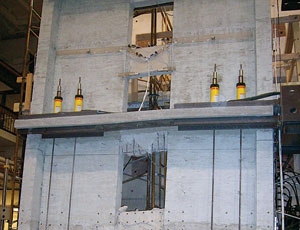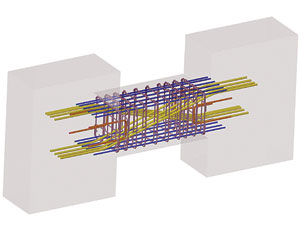A structural engineer is poised to be the first to use steel fibers as structural reinforcing in the lateral-force-resisting system of a concrete-framed high-rise in a seismic zone. The application, designed to reduce reinforcing-steel congestion in shear-wall link beams and, perhaps, in shear walls themselves, is based on recent successful performance tests of SFRC link beams at the University of Michigan, Ann Arbor.


Shear walls in high seismic regions are typically heavily congested. Link beams, which occur above wall openings, are especially challenging; they require large diagonal bars that are known to be difficult and time-consuming to place.
“Steel fiber promises to solve this problem,” says Cary Kopczynski, president of the Bellevue, Wash.-based structural firm that bears his name. The engineer has designed two, 40-story towers in Seattle using SFRC link beams. Thanks to the recession, both are on hold.
Steel fiber can reduce about 40% of link-beam rebar, Kopczynski says. It also allows smaller-diameter, more bendable diagonal bars to exit the beam horizontally in shorter lengths. “This is huge,” he says. “Many, if not most, link-beam problems will be solved with elimination of the long, heavy diagonal-bar tails that conflict with adjacent wall steel.”
Kopczynski may also use steel fiber throughout the walls at lower levels of both buildings, depending on the timing of usable design information resulting from the University of Michigan tests. For some shear-wall applications, “we believe SFRC will also provide strength, stiffness, ductility and buildability benefits to the entire shear-wall system,” he says.
A net cost reduction of 20% to 30% over conventional link beams is possible, says Kopczynski. Depending on the number of link beams per floor, schedule improvement can be anywhere from nothing to very significant. “A full day per floor would not be unreasonable,” he says.
SFRC, typically used for crack control in footings, piles, slabs, walls, beams, columns and roofs, is not yet in the building code for seismic applications. But that is expected to change, say researchers. For permitting purposes, Kopczynski will apply for use of steel fiber under the alternate materials, design and methods of construction process in Section 104.11 of the “2006 International Building Code.”
SFRC is promising, but practicalities need to be addressed regarding constructibility, says Joe R. Maffei, principal of structural engineer Rutherford & Chekene, San Francisco. R&C provided suggestions on the designs of test specimens for the University of Michigan tests, and reviewed the results to ensure the link beams could undergo at least the same amount of earthquake deformation as more conventional beams. Maffei also performed a peer review for the 440-ft-tall 815 Pine, one of the two Kopczynski towers on hold.
There would be a need to mix a different batch of concrete on-site and a need for some kind of boundary element between the SFRC and the conventionally reinforced concrete, says Maffei.
In seismic SFRC, the fibers consume about 1.5% of the volume of the concrete mix. The tests, performed last year, were on two four-story coupled-wall specimens, built at approximately one-third scale and subjected to earthquake-type lateral displacement reversals. Slabs were built at the second and fourth levels.
The steel fiber used was 1.2 in. long, with hooked ends for anchorage. Tensile strength was over 400,000 psi. “This is actually 57 miles of wire contained in one cubic yard of concrete,” says Jeff Novak, technical manager for building products with Bekaert Corp., Atlanta, which supplied the tests’ high-strength fiber.
The tests confirmed that the system, using precast-concrete link beams in this case, can “fully confine the diagonal rebar and demonstrated the significant contribution to shear capacity and damage tolerance” of SFRC, say civil engineering Professors J.K. Wight and G.J. Parra-Montesinos and Ph.D. candidate in civil engineering R.D. Lequesne. The three conducted the tests, called Seismic Detailing and Behavior of Coupled-Wall Systems With High-Performance Fiber-Reinforced Concrete, under a National Science Foundation grant.
“Leading-edge efforts like [Kopczynski’s] are important to iron out any practical difficulties and obstacles to wider implementation of new technology,” says Maffei.


Post a comment to this article
Report Abusive Comment